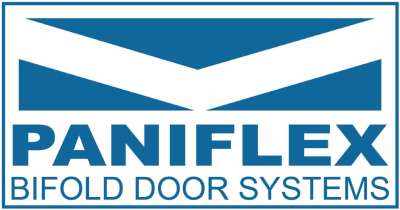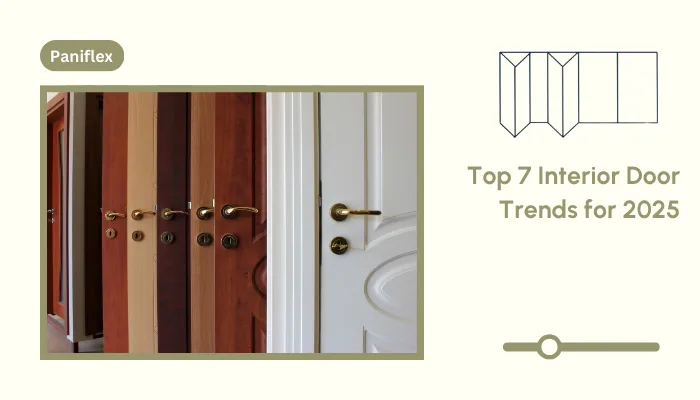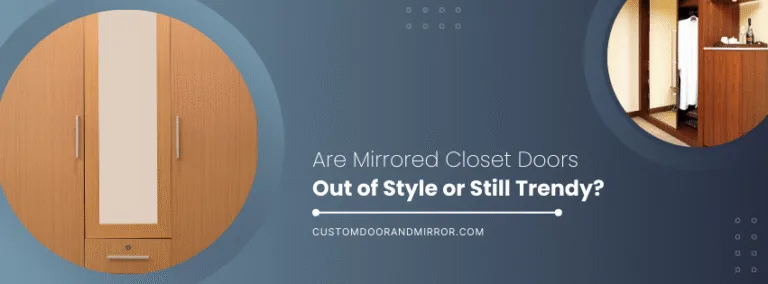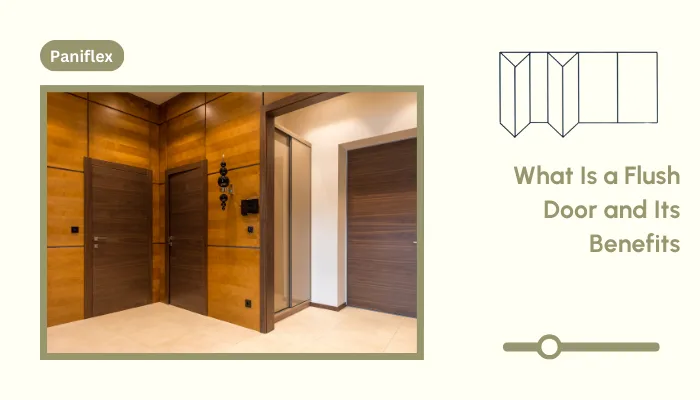Interior doors have evolved from being purely functional to becoming integral design elements that shape the flow and character of a space. Fresh trends are emerging in 2025 that blend style, sustainability, and advanced functionality for modern residential and commercial projects.
We understand how challenging it can be to keep pace with evolving design preferences while ensuring doors meet structural and performance expectations. This guide explores the top interior door trends set to define 2025, offering insights to help you specify, design, and install doors that align with contemporary styles and client expectations.
Ready to experience the benefits of custom closet doors? Explore our range of Paniflex products now.
In a nutshell:
- Interior door trends for 2025 feature minimalist flush designs, sustainable materials, bold colors, glass-metal hybrids, and smart technology.
- Understanding these trends helps professionals design spaces that feel current while ensuring functional and long-lasting door systems.
- Challenges like material sourcing, installation complexity, and balancing style with performance require careful planning.
- Precision fabrication and thoughtful specification are key to successfully implementing trend-driven door designs in any project.
Why Is 2025 a Turning Point for Interior Door Design?
Interior doors are no longer treated as afterthoughts in architectural planning. In 2025, we see a shift driven by changing lifestyles, technological advancements, and a renewed focus on sustainable and functional spaces.
Understanding the following drivers can help professionals deliver designs that are not just visually appealing but also future-ready.
1. Demand for Multi-Functional Spaces
With smaller urban homes and flexible workspaces, doors are expected to do more. You need them to divide, connect, and enhance space without compromising design style.
This shift has led to the rise of doors that offer both practicality and style, from sliding doors that save space to bi-fold doors that provide a seamless flow between indoor and outdoor areas. These versatile solutions help maximize space without sacrificing design.
2. Rising Focus on Sustainability
Doors are increasingly being made from eco-friendly materials like reclaimed wood, bamboo, and recycled composites, which not only reduce environmental impact but also contribute to green building certifications such as LEED.
Furthermore, finishes like low-VOC paints and natural oils are being used to minimize indoor air pollution, while energy-efficient doors help with insulation and temperature control.
3. Integration of Technology
Smart door systems now come equipped with a range of electronic features designed to enhance convenience and security. For example, smart locks with keyless entry, fingerprint scanning, and remote control capabilities offer increased security and ease of access.
Other innovations include soft-close mechanisms that prevent slamming, soundproof doors with acoustic insulation for noise control, and doors with built-in lighting systems that automatically turn on as you approach.
2025 marks a pivotal moment for interior door design, driven by evolving lifestyles and technological advancements. Let’s explore the seven trends that are shaping the future of interior doors this year.
Suggested Read: Choosing the Best Material for Closet Doors
7 Trends Shaping Interior Door Design in 2025
As we move into 2025, interior doors are becoming pivotal design elements that reflect modern lifestyles, technological integration, and a heightened focus on sustainability.
Here are seven key trends shaping the future of interior doors:
1. Minimalist Flush Designs
Clean-lined flush doors are becoming a top choice in modern interior design due to their ability to seamlessly integrate into minimalist spaces. Their smooth, flat surface and understated elegance make them a perfect fit for contemporary aesthetics.
Trend Highlights:
- Concealed hinges and frameless door systems for a smooth, unbroken wall surface.
- Pocket and pivot doors are replacing traditional swing doors in tight spaces.
Why It Works: Flush doors enhance contemporary looks while maximizing usable floor area, especially in compact spaces where every inch counts.
Applications: Residential apartments, luxury hotels, and commercial office interiors with minimalist design themes.
2. Natural Textures and Sustainable Materials
Designers are increasingly focusing on eco-conscious materials and organic finishes to bring warmth and texture indoors, blending nature with design. This trend aligns with the growing demand for sustainable, environmentally responsible choices.
Trend Highlights:
- Solid wood, bamboo, and reclaimed timber for natural appeal.
- Low-VOC finishes and FSC-certified materials support green building standards.
Why It Works: This trend combines visual appeal with environmentally responsible design, aligning perfectly with certifications like LEED and WELL, ensuring spaces are both beautiful and sustainable.
Applications: High-end residential projects, wellness-focused interiors, and boutique retail spaces.
3. Bold Colors and Statement Doors
Stepping away from muted tones, bold-colored doors are making a statement in interior design, becoming the focal point in rooms. These doors are not just functional; they also serve as bold design elements.
Trend Highlights:
- Jewel tones, matte blacks, and high-gloss primary colors as focal points.
- Geometric patterns and artistic inlays for added drama.
Why It Works: Bold-colored doors create a sense of identity and inject personality into spaces, especially when used in otherwise neutral interiors, providing a visual anchor for the room.
Applications: Feature entrances in hospitality settings, modern homes, and creative workspaces.
4. Glass and Metal Combinations
The fusion of glass and metal is redefining door design by balancing transparency with strength. This trend offers a modern, industrial aesthetic that complements both residential and commercial interiors. This combination is especially popular in open-plan spaces, where maintaining a sense of flow and connectivity is essential.
Trend Highlights:
- Black steel frames with glass panels for an industrial-modern design.
- Frosted glass for privacy without sacrificing natural light.
Why It Works: The combination supports light flow and spatial continuity while offering functional zoning, maintaining an open feel without compromising privacy.
Applications: Office partitions, upscale residential interiors, and restaurant spaces.
5. Smart Door Technology
Doors are evolving with integrated smart systems to meet the demands of connected living. Features like smart locks, biometric fingerprint scanners, and keyless entry allow for secure and seamless access. Additional innovations, such as motion-activated door openers and soft-close systems, cater to the growing demand for automation in everyday life.
Trend Highlights:
- Smart locks, fingerprint scanners, and keyless entry systems.
- Motion-activated door openers and soft-close mechanisms for convenience.
Why It Works: Smart door technology improves security and user experience, meeting the needs of modern residential and commercial spaces where automation is becoming the norm.
Applications: High-end residences, co-working spaces, and hospitality suites.
6. Customization-Driven Solutions
Customization is taking center stage in interior door design, offering tailored solutions that reflect personal style and functional needs. With advancements in door fabrication, designers now have the flexibility to create doors that are uniquely suited to a space’s vision.
Trend Highlights:
- Fully customized sizes, finishes, and hardware combinations.
- Ability to integrate branding or artistic elements into panels.
Why It Works: Customization provides unparalleled flexibility, allowing architects and designers to achieve one-of-a-kind looks that align perfectly with the overall design concept.
Applications: Luxury homes, branded retail spaces, and flagship commercial projects.
7. Acoustic and Soundproofing Doors
These specialized doors are built with dense materials or acoustic panels that prevent sound transmission, ensuring a quiet, focused atmosphere. The demand for these doors is driven by the rise of home offices, entertainment spaces, and high-traffic commercial areas where noise reduction is essential.
Trend Highlights:
- Doors designed explicitly for soundproofing (e.g., acoustic panels, dense materials).
- Acoustic glass panels for noise isolation in offices, conference rooms, and luxury residences.
Why It Works: These doors are essential for creating serene environments, ideal for spaces that require privacy and noise reduction, such as home theaters, recording studios, and private offices.
Applications: Commercial spaces like conference rooms and residential areas that need noise isolation.
These emerging trends highlight how interior doors are becoming increasingly crucial to achieving modern design objectives.
Suggested Watch: Now that you know about trending interior doors, explore timeless trends in interior design in this video.
How to Choose the Right Door for Your Space?

Selecting the ideal door involves more than just design appeal. It requires careful consideration of functionality, materials, and technical requirements to ensure the door integrates seamlessly into the space while delivering long-term performance.
These are a few factors to consider when choosing a door for your client’s space:
- Functionality of the Space: Identify whether the door is for privacy, light flow, noise control, or as a statement piece.
- Material Suitability: Choose materials based on environmental conditions, usage frequency, and maintenance expectations.
- Door Movement: Assess swing clearance, sliding options, or folding mechanisms for compact areas.
- Hardware and Technology Integration: Ensure hinges, locks, and smart features complement the door style and usage needs.
- Performance Standards: Look for fire ratings, acoustic ratings, and sustainability certifications where applicable.
Even with the right choice, incorporating trend-forward doors often presents challenges during design and installation. Let us explore common pitfalls and how to address them effectively.
Suggested Read: DIY Guide: Installing Sliding Closet Doors on Concrete
Challenges of Incorporating Trend-Driven Doors
While trend-driven interior doors elevate a space, they often bring unique challenges for professionals during design and installation. Recognizing these issues early helps ensure seamless integration and client satisfaction.
You should consider the following issues beforehand to ensure a smooth installation:
1. Sourcing High-Quality Materials
Low-grade alternatives, such as cheaper composite woods or low-quality metals, can lead to visible wear, structural weaknesses, and a diminished look. This undermines both design intent and door longevity.
One solution is to partner with trusted fabricators offering diverse, high-quality material options. This ensures both design intent and functional longevity are preserved.
2. Installation Complexity
Minimalist flush doors and oversized panels demand precise framing and advanced hardware systems. These requirements can overwhelm teams accustomed to traditional installations.
Engaging experienced installers familiar with such systems helps avoid misalignment and performance issues. Providing detailed technical drawings and pre-installation planning also reduces onsite complications.
3. Performance Standards
Trendy designs like full-height glass or ultra-thin frames may compromise acoustic or fire safety standards. Balancing visual impact with code compliance requires careful specification of materials and components.
Selecting certified acoustic glass reduces noise transmission by absorbing sound waves, and fire-rated cores provide resistance to heat and flame spread. Additionally, concealed seals maintain airtightness, which preserves both function and form.
4. Cost and Timelines
Custom doors with unique finishes or integrated technology often come with extended lead times and higher costs, meaning projects may take longer and be more expensive.
Clear communication about timelines and pricing, along with value engineering options, helps maintain trust. Offering alternative finishes or modular designs can also keep projects on schedule and budget.
Overcoming these challenges requires expertise, precision, and reliable partnerships. Here is how Custom Door & Mirror helps professionals deliver trend-driven door solutions without compromise.
From the Community: Get useful tips from this Reddit thread to update interior doors.
Stay Ahead with Custom Door & Mirror

Delivering trend-driven interiors requires more than vision since it demands precision engineering and reliable fabrication. At Custom Door & Mirror, we help professionals bring complex door designs to life with solutions tailored to modern architectural needs. Our expertise ensures that all custom doors meet both design and performance expectations.
These are a few reasons to choose us:
1. Precision Fabrication
Precision fabrication involves manufacturing doors with exact measurements, tight tolerances, and seamless hardware integration, ensuring flawless fit and function even for complex designs.
We specialize in crafting doors with intricate details, tight tolerances, and advanced hardware integration. This precision allows trend-forward designs like flush doors, oversized panels, and glass-metal hybrids to perform flawlessly.
2. Extensive Material and Finish Options
From solid woods to sustainable veneers and custom metal trims, our material portfolio supports diverse design visions. We offer finishes that align with trending styles, including matte, gloss, and textured effects.
Every material is selected for durability and ease of maintenance in high-use environments. This flexibility empowers architects and designers to fully realize their concepts.
3. Seamless Hardware Compatibility
Our frames and panels are fabricated to accommodate concealed hinges, smart locks, and soft-close systems without compromise. This ensures doors not only look sleek but also function seamlessly over time.
By aligning fabrication with hardware requirements, we reduce the risk of misalignment or operational issues. This integration is critical for executing modern door systems efficiently.
4. Scalable Solutions
Whether it is a single bespoke door or a large-scale commercial fit-out, we adapt to your project scale without sacrificing quality. Our processes are designed to maintain consistency across multiple units, making us ideal partners for residential, retail, and corporate projects. Professionals benefit from a partner who understands the demands of high-volume and custom work alike.
Staying ahead of design trends requires a partner who can deliver precision, flexibility, and consistent quality. Custom Door & Mirror supports professionals in creating doors that elevate spaces and stand the test of time. Explore our solutions to bring your next project’s vision to life with confidence.
Suggested Read: Standard Linen Closet Door Sizes: Essential Guide
Conclusion
Interior doors are no longer passive architectural elements; they are active contributors to design, functionality, and the overall experience of a space. As 2025 brings new materials, technologies, and design preferences into focus, professionals must balance these trends with performance, practicality, and project constraints.
Staying informed allows contractors, designers, and architects to make decisions that resonate with both modern style and long-term reliability. At Custom Door & Mirror, we help you bridge this gap with precision-engineered doors that support cutting-edge designs. Our expertise covers advanced fabrication techniques, seamless hardware integration, sustainable material options, and scalable solutions for projects of any size.
Discover how Custom Door & Mirror can support your next project. Contact us for doors that meet today’s design demands with precision and style.
Ready to experience the benefits of custom closet doors? Explore our range of Paniflex products now.
Frequently Asked Questions
1. What interior doors are in style in 2025?
Minimalist flush doors, glass-metal hybrids, and bold statement doors dominate 2025. Sustainable materials, concealed frames, and smart technology integration are key features, offering both design appeal and functional advantages for modern residential and commercial spaces.
2. What interior design is in for 2025?
Trends in 2025 focus on warm minimalism, natural textures, and multi-functional spaces. Designers favor clean lines, sustainable materials, and technology integration to create interiors that balance visual sophistication with practical performance in both homes and workplaces.
3. What is the trend in door hardware in 2025?
Concealed hinges, matte black or brushed brass handles, and smart locks lead hardware trends. Soft-close systems and touchless technology are also growing in popularity for enhancing functionality and aligning with sleek, modern door styles.
4. What are the popular door colors in 2025?
Deep jewel tones, matte black, and warm neutrals like beige and greige define 2025’s color palette. Bold hues are often used as accent doors, while softer tones maintain timeless appeal in minimalist or natural interiors.
5 .What are the colors for 2025 door knobs?
Matte black, brushed brass, and satin nickel dominate 2025 door knob trends. Warm metallics and minimalist finishes complement modern interiors, while bold tones like deep bronze offer statement options for designers seeking a distinctive, contemporary touch.






